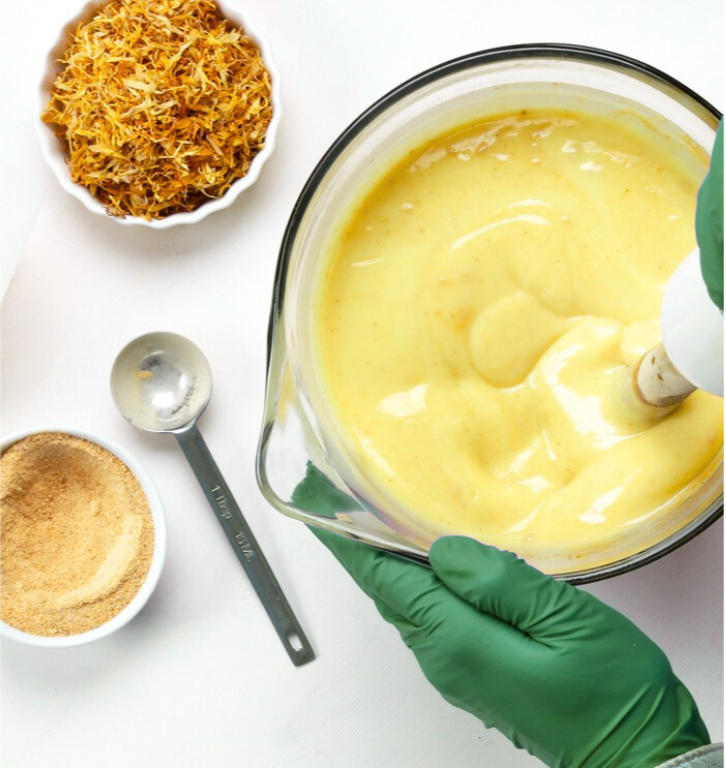WHAT IS THE COLD PROCESS METHOD?
The cold process method is a unique, centuries-old technique of soap making that uses natural ingredients without applying external heat. By blending oils and fats with an alkali (like sodium hydroxide), cold process soap forms through a chemical reaction called saponification. The result is a natural, handmade soap that retains all the beneficial properties of the oils used.
This method involves careful mixing and curing of the soap over several weeks, which allows the oils to gently transform into soap without the need for cooking or additives that may interfere with their natural qualities.

benefits for your skin
WHY IS COLD PROCESS SOAP GOOD FOR YOUR SKIN?
Nutrient-Rich Soaps
Because no heat is added during the process, cold process soaps preserve the original nutrients in the oils and butters used, such as vitamins, antioxidants, and essential fatty acids. These natural elements offer unique benefits to your skin, like deep hydration, soothing effects, and nourishment.
Moisture-Retaining Glycerin
Cold process soap making naturally produces glycerin, a humectant that draws moisture to the skin, helping it stay soft and hydrated. Unlike commercial soaps, which often remove glycerin to sell separately, cold process soap retains it, giving you a soap that’s more gentle and moisturizing.
Free of Unwanted Additives
Cold process soaps don’t require synthetic detergents, preservatives, or foaming agents, making them cleaner and safer for your skin. By using only natural ingredients, these soaps avoid the harsh additives commonly found in commercial soap products.
WHY IS COLD PROCESS BETTER THAN TRADITIONAL METHODS?
Traditional soap-making techniques, like the hot process, rely on cooking oils and lye to speed up the soap-making process. While these methods still use natural ingredients, the high heat can break down delicate nutrients and reduce the potency of natural oils, leading to a less nourishing final product.
The cold process method, on the other hand:
Preserves Natural Properties
By skipping the added heat, cold process soaps maintain the full integrity of oils and essential oils, which is beneficial for sensitive skin and therapeutic purposes.
Offers Customization
Cold process soap makers can carefully select ingredients to target different skin needs, like acne, dryness, or sensitivity, offering a personalized and nourishing experience.
Creates a Silky Texture
The slow curing process of cold process soaps results in a smooth, luxurious texture that makes for an elevated bathing experience.
COLD PROCESS SOAP BARS VS. COLD PROCESS LIQUID SOAP
While cold process is common for solid soap bars, it’s more challenging to create liquid soap using the cold process method.
Here’s how they differ:
Solid Soap Bars
For solid soap bars, the soap is mixed, molded, and cured for 4–6 weeks. This traditional method keeps the ingredients simple, allowing them to retain their natural benefits. The result is a firm, nourishing bar that is rich in beneficial compounds, perfect for gentle, everyday use.
Liquid Soap
Liquid soap requires potassium hydroxide (KOH) instead of sodium hydroxide (NaOH) for a liquid consistency. Cold process liquid soap making is rare, as it’s challenging to achieve the right texture without heating. Liquid soaps also require a higher water content, making it harder to retain the same nutrient density as bar soap. Due to these complexities, most liquid soaps on the market use hot process methods.

why choose cold process?
Choosing cold process soap means embracing a more natural, nutrient-dense way to care for your skin. By avoiding high temperatures and synthetic additives, cold process soaps provide a gentle, moisturizing cleanse that’s kinder to your skin and the environment. Explore our collection and discover a soap made with care, patience, and pure ingredients—perfect for skin that deserves the very best.
